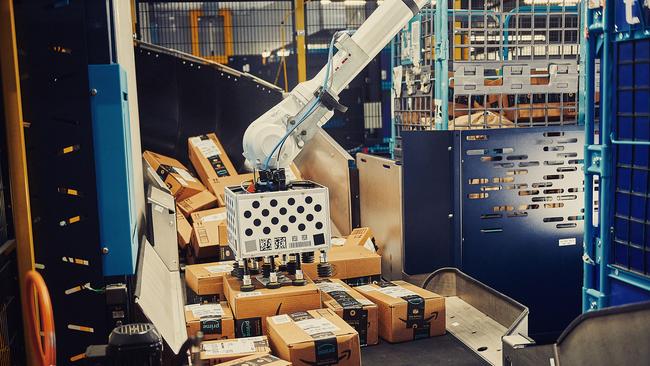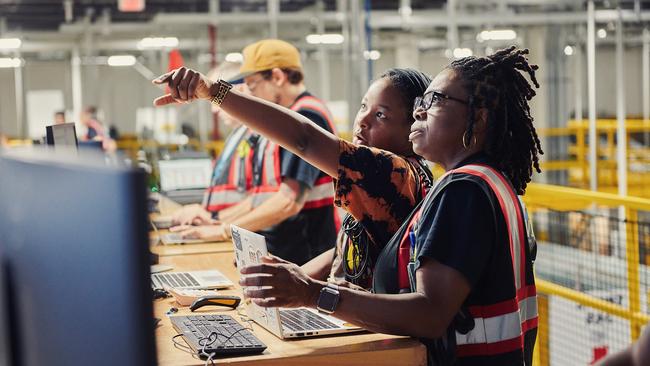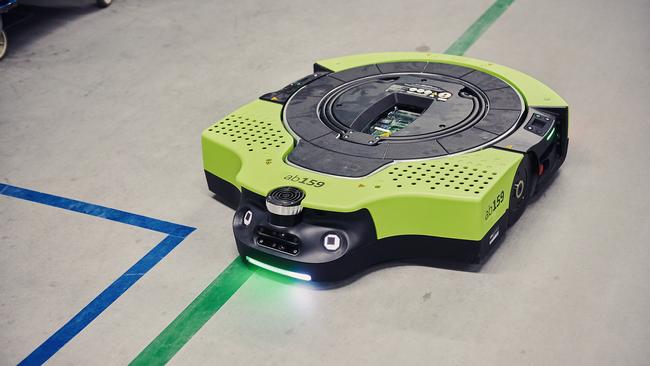Amazon and MIT study shows how robots will save workers six weeks a year
Robotics and automation are changing workplaces, with Australian workers ‘neutral’ towards the shift, according to MIT. But if you’re good at problem solving, here’s how you can benefit.

Business
Don't miss out on the headlines from Business. Followed categories will be added to My News.
Australian workers say automation and artificial intelligence could save them 245 hours a year – more than six weeks – potentially creating greater job satisfaction and work/life balance, a new study has found.
Research commissioned by Amazon has taken the spotlight away from the rise of artificial intelligence among knowledge workers to look at how automation is affecting blue-collar workers.
Amazon Robotics principal tech program manager Mikell Taylor said 91 per cent of Australian workers who have experience working with robots said it had changed their workplace for the better.
“While robots may not be able to manage your inbox or take your place in meetings, they can help with repetitive or physical tasks enabling workers to focus on more rewarding activities while also creating a safer workplace,” Ms Taylor said.

The research by Lonergan Research was based on a survey of 1000 Australians. Other findings included 79 per cent believing machine tools, industrial robots and artificial intelligence were relevant to their jobs, while 59 per cent said they would use time saved on finding a better work/life balance.
But a separate Massachusetts Institute of Technology study found Australians were more neutral to automation in workplaces.
And in the US, the MIT study found workers were negative, with concerns about job security. But Ben Armstrong, executive director and a research scientist at MIT’s Industrial Performance Centre, said in France and Germany sentiment was more positive.
“Our hypothesis, at least, is that if you have those strong worker institutions where workers feel cared for by government or by industry associations or unions, you might be less likely to say negative things about automation,” Armstrong told The Australian on the sidelines of Amazon’s Delivering the Future event in Nashville.

“(But) one of the things that we found was that workers who said their employers had already adopted AI, robotics, or these advanced technologies, when they saw it in their workplace, they were more optimistic.
“It seemed like with exposure to these technologies, workers realised this might lead to better job paths, and that was an interesting finding. It wasn’t that once you’re more exposed, you become more fearful. It was ‘oh, this isn’t so bad, after all’.”
Armstrong said employers therefore needed to find ways to expose staff to automation to help combat the technology’s “double-edged sword”.
“On the one hand, workers are very excited about new technologies because it could just make their job … easier, give them more opportunities to develop new skills, climb a learning curve.
“But there are other potential downsides or uncertainties that come along with it, and I think that might just be a reality that workers are going to navigate, and that might … go away once they get more exposed to it.”

But in a tight labour market, some employers are fearful about upskilling their employees too much in case they are poached by rivals.
“Employers often under invest in training and upskilling because they worry about turnover, that I’m going to train this person for six months and then they’re going to leave and go to my competitor and work there. So that’s why we often see at the employer level less training than we might expect,” Armstrong said.
“So one thing that we see as a big possibility is employers partnering with public institutions, with public universities, vocational programs, to share the cost and share the risk of training, so … if an employee goes to them or goes to their competitor, it’s not that big of a deal, because overall, the skill level of the pool of workers goes up.”
Amazon says since 2020, it has spent more than $US1.2m on training for 300,000 employees for “high-growth jobs”. This includes training in robotics, engineering, and other technical roles that are in demand as its operations evolve.

Demographer Bernard Salt said automation and robotics delivered three benefits: workforce expansion, higher-valued jobs and workplace safety.
“Technological advancements are not just improving efficiency, they’re enhancing our overall lifestyles. We’re seeing increased pay and improved job satisfaction. The low unemployment rate reflects a robust economy ready to reap the benefits of technological innovation,” Mr Salt said.
“AI, robotics and technology-related roles have experienced the second largest growth over the decade – up 109,955 jobs according to ABS (Australian Bureau of Statistics) data for the decade to February 2024 – contributing strongly to the 25 per cent increase in the Australian workforce over the same period.
“Through the reduction of monotonous, repetitive or boring tasks, automation and robotics are also improving job safety, minimising workplace hazards, contributing to a healthier workforce overall.”
The author travelled to Nashville as a guest of Amazon.
More Coverage
Originally published as Amazon and MIT study shows how robots will save workers six weeks a year





